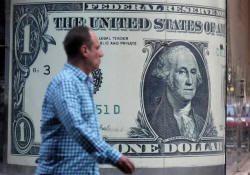|
Ding-dong the VIX is dead
(but risk is rising): James Saft
 Send a link to a friend
Send a link to a friend
 [November 17, 2016]
By James Saft [November 17, 2016]
By James Saft
(Reuters) -
The
VIX, the so-called fear gauge, is dead but the real risk-appetite index
is falling.
The dollar is the new and true North Star of global markets, according
to a study released on Tuesday by the Bank for International
Settlements, with a rising dollar coinciding with falling risk
tolerance.
This just in time for the Trump era, widely expected to bring with it
rising inflation and interest rates driving a rising dollar.
With the advent of quantitative easing and other extraordinary monetary
policy in the aftermath of 2008, the old relationship between the VIX
index of implied volatility in equity markets and banks’ willingness to
use leverage broke down. As investors use borrowed money to add risk,
having a measure of how much they were laying on was crucial. Indeed,
despite the VIX remaining at historically low levels, borrowing by
capital market banks has fallen, in part also perhaps because of new and
tighter regulation.
Over the same period, analysts have been puzzled by the fact that people
wanting to borrow dollars in foreign exchange markets have paid
above-market interest rates, something which should be “impossible” if
only there are people with money willing to step in and arbitrage this
risk-free gap.
So whereas a decade ago you could look at the VIX and see risk appetite
in a single price, now the relationship is better expressed by the value
of the dollar, which tracks banks’ willingness to use their capital to
arbitrage gaps in forex market interest rates.

“Just as the VIX index was a good summary measure of the price of
balance sheet before the crisis, so the dollar has become a good measure
of the price of balance sheet after the crisis,” BIS Head of Research
Hyun Song Shin, one of the authors of the study, said in a speech on
Tuesday.
“The mantle of the barometer of risk appetite and leverage has slipped
from the VIX, and has passed to the dollar.”
(http://www.bis.org/publ/work592.pdf)
And the important point is that cross-border lending falls as the dollar
gets stronger. Shin theorizes that this is because so many global
institutions have high dollar liabilities, often because they’ve sought
higher-yielding paper denominated in dollars. The more the dollar rises,
the more painful this “naked currency mismatch” becomes. To compensate,
they cut back on the use of leverage.
TRADE SLOWDOWN EXPLAINED?
All of this may help to explain yet another puzzle; the sub-par growth
in global trade.
One of the huge changes in the global economy over the past two decades
is the growth of complex and far-flung value chains, set-ups in which
goods are manufactured in varying stages all over the world.
While this does a good job of taking advantage of lower wages in places
like Asia, it is highly dependent on dollar financing being available to
fund the exchange of first a raw material from where it is produced to
where it will go into an auto part, for example, and then on to where
the parts are assembled.
[to top of second column] |

A man walks past a currency exchange bureau advertisement showing an
image of the U.S. dollar in Cairo, Egypt, November 11, 2016.
REUTERS/Mohamed Abd El Ghany

As the dollar has strengthened since 2014, global trade growth has
slowed, actually turning negative in Asia outside China. We don’t know
for sure, but a higher cost of dollar financing as the dollar rises may
be acting as sand in the wheels of global trade.
This brings us round to President-elect Trump and the strong dollar. The
trade-weighted dollar index has risen rapidly since the election,
hitting its highest level on Wednesday since April of 2003, a time,
ironically, when U.S. and allied forces were “mopping up” after the
second Iraq War.
The simple explanation for why the dollar is going up in anticipation of
the Trump administration is that he’ll engineer a stimulus which will
drive demand, and with it inflation. This will prompt, or allow if you
prefer, the Federal Reserve to tighten interest rates more quickly than
they otherwise would.
Fed fund futures are assigning a 90 percent chance to a 25-basis-point
hike by the Fed at its policy meeting concluding Dec. 14.
Higher yields at the short end will drive up yields at the longer end,
something we’ve already seen to a remarkable degree, and in
lower-quality bonds too. This will attract more investors to the dollar
and dollar-denominated securities, driving up its value. A stronger
dollar could thus not just reflect stronger activity in the U.S., but
also slow trade and activity elsewhere as banks become less willing to
use or provide leverage.
If the Federal Reserve is able to normalize, the old relationship
between volatility and risk appetite may come back.
A stronger dollar may be in someone’s interest, but it is hard to work
out who, exactly, that would be.
(Editing by James Dalgleish)
[© 2016 Thomson Reuters. All rights
reserved.] Copyright 2016 Reuters. All rights reserved. This material may not be published,
broadcast, rewritten or redistributed.
 |